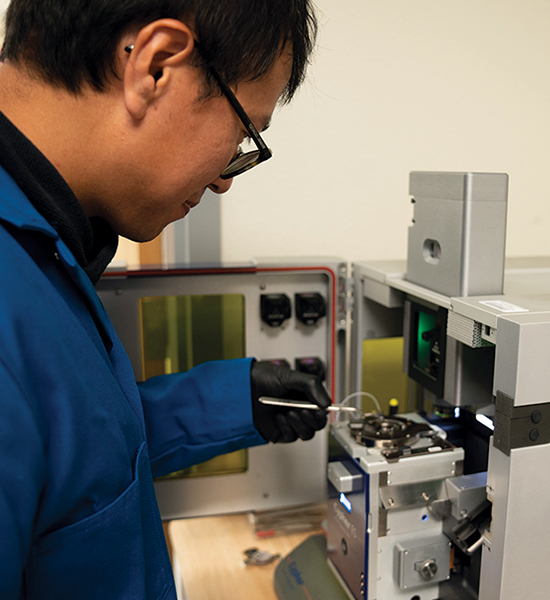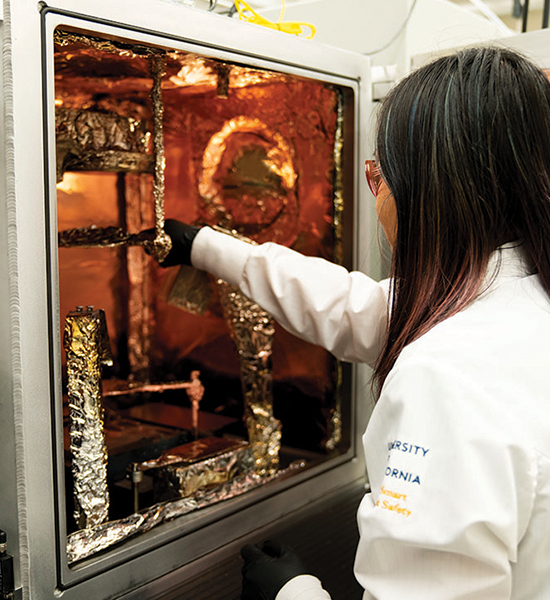Gorodetsky’s infrared technology makes a splash in the scientific community and beyond.
A not-so long time ago, at a campus not-so-far away, Alon Gorodetsky, UCI associate professor of chemical and biomolecular engineering, developed materials that have the ability to revolutionize infrared camouflage and thermal management. Simply put, Gorodetsky has developed adaptive infrared reflecting materials, or materials that change and adapt how they reflect infrared radiation and heat for a specific purpose. These materials draw inspiration from the structures of color-changing cells and organs found in squid skin.
But it wasn’t always about adaptive materials and squids.
Gorodetsky originally focused his research on organic electronic materials for biosensors and solar cells, but quickly pivoted his career in 2011 to study adaptive materials inspired by the skin of cephalopods, like the common pencil squid. After walking into a talk given by Roger Hanlon, senior scientist at the Woods Hole Marine Biological Laboratory, Gorodetsky became fascinated by the ability of cephalopods, or predatory mollusks such as octopus, cuttlefish or squid, to change their color, shape and texture. The rest is not-so-distant history.

“It just blew me away, it was like seeing something out of a science fiction movie,” said Gorodetsky. “Basically I threw [out] half the work I was planning on doing and said ‘okay, let’s work on this instead.’”
How it works
The materials mimic a cephalopod’s complex skin structure or their camouflage ability. The skin of many cephalopods contains different color-changing components, including cells called leucophores and iridophores, as well as organs called chromatophores, which work together to help the animal change color and camouflage itself in different surrounding environments.
According to current understanding, leucophores reflect light to provide a white diffusive background. Iridophores reflect light of different wavelengths and are iridescent. Chromatophores are muscle-controlled organs that expand and contract in size – behaving like spectral filters. These cells and organs allow cephalopods to not only camouflage themselves, but also to communicate with other animals.
“Cephalopod skin is like this amazing bioelectronic display, that’s how I think about it,” said Gorodetsky. “The skin kind of has the complexity and patterning abilities similar to, let’s say, an advanced LCD screen, when it changes color, and then it can also change shape – with some limitations. It’s really a remarkable system.”
Gorodetsky and his research team began their work seven years ago by studying reflectin, a protein essential for the color-changing and light-reflecting functionality of some cephalopod skin components. The team used this protein to make thin films that change color, which eventually led them to design “invisibility stickers” that can help military personnel disguise themselves from visualization under low light conditions. These early experiments led to the team’s more advanced recent research with artificial materials.
His lab is currently focused on better understanding reflectins and using these proteins for bioelectronics, renewable energy and camouflage applications. His lab also distills core engineering principles gleaned from studying the protein-based biological systems and translates them to develop artificial thermal management materials that have new cephalopod-like functionalities.
“Alon is very passionate and enthusiastic about his team and his research,” said Chengyi Xu, a materials science and engineering graduate student. “I want to see this research translate into something on the market, something we can use. Everything we do in this lab, we can see and touch it. I think it would be great to see what we are doing right now used in some application in the real world.”
Where it can be used
A key aspect and one application of Gorodetsky’s adaptive infrared reflecting materials is controlling where heat goes.
“For infrared, there’s the kind of deception aspect … fooling infrared cameras,” said Gorodetsky. “But there’s also a lot of places in life where adaptively controlling infrared radiation, or changing how it is transmitted or reflected by objects, would be a huge advantage.”

If the technology is integrated into textiles, the wearer could control how the clothing reflects infrared radiation to keep them warm or cool on demand. The technology can also be applied to shipping containers for perishable items, giving the shipping company the ability to control the local thermal environment in the container to prevent food from spoiling.
Commercialization
In 2013, Gorodetsky met with Doug Crawford, UCI Applied Innovation’s senior licensing officer, who helped Gorodetsky get started on the filing process for several patents and, subsequently, introduced Gorodetsky to Applied Innovation’s entrepreneurial resources.
“One of the things that makes working with Alon so enjoyable is that he understands the power of telling a story and how his technology relates to the everyday world,” said Crawford. “Alon makes things more accessible to any audience … by putting it in terms that make sense and how what he’s doing can potentially intersect your life or the lives of people you might know.”
Gorodetsky’s research has primarily received funding from the Defense Advanced Research Project Agency, the Air Force Office of Scientific Research and the Advanced Research Projects Agency-Energy (ARPA-E).
In December of the same year, Gorodetsky, along with about 100 other scientists, was named by President Barack Obama as a recipient of the Presidential Early Career Award for Scientists and Engineers. The award is considered the highest honor from the United States government for science and engineering professionals who are in the early stages of their independent research careers.
Despite his technology’s many applications, Gorodetsky’s laboratory has primarily focused on clothing or personal thermal management. He has previously received a joint grant with Under Armour through the ARPA-E to develop wearable materials and is currently exploring extensions of this work. According to Gorodetsky’s research publication “Adaptive Infrared-Reflecting Systems Inspired by Cephalopods” featured in Science, different variants of these materials can be developed for wearable applications and can adapt themselves like squid skin.
Goals

Within the Gorodetsky Lab are more than 15 researchers, all with diverse backgrounds that range from materials science and engineering to molecular biology. Gorodetsky aims to move his lab’s focus toward working with more biological systems to gather a different perspective.
“If you can understand the animal’s skin better, you can do more interesting things with applications,” said Gorodetsky. “So far, we’ve just studied only certain parts of the system at the molecular level, specifically the proteins found in some of the skin cells.”
The research team also plans to continue development of practical applications for energy management to configure a material focused on providing people with the ability to control their local temperature and use less energy for heating ventilation and air conditioning.
“Once we get over some manufacturing hurdles, I think we could have a practical technology from an energy management perspective, something that could help people control their local temperature, which would let you use less energy for heating ventilation and air conditioning” said Gorodetsky. “It happens to be a very important global problem … that’s where technologies like the things we’re developing could be impactful and useful.”
For more information about Gorodetsky’s research and lab, visit here.